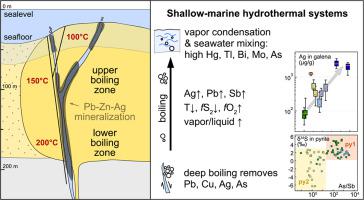Chemical Geology ( IF 3.6 ) Pub Date : 2021-07-28 , DOI: 10.1016/j.chemgeo.2021.120457 Anna Schaarschmidt 1 , Karsten M. Haase 1 , Reiner Klemd 1 , Manuel Keith 1 , Panagiotis C. Voudouris 2 , Dimitrios Alfieris 3 , Harald Strauss 4 , Michael Wiedenbeck 5

|
Boiling is a crucial process triggering ore formation in magmatic-hydrothermal systems and controlling the enrichment of precious and rare metal(loid)s in epithermal-porphyry mineralizations. Steep physicochemical gradients during boiling of hydrothermal fluids at shallow water depths caused metal(loid) precipitation along a 3 km long Pb-Zn-Ag vein system on Milos Island in the South Aegean Volcanic Arc. We present new trace element and Pb, Sr, and S isotope data from sulfides providing insights into the diversity of mineralization processes in shallow-marine hydrothermal systems. Lead and Sr isotope compositions of sulfides and sulfates reflect the mixing of fluids that reacted with metamorphic basement and the volcanic host rocks, whereas some of the S were derived from seawater. Investigation of mineralized samples along the Kondaros-Vani fault zone revealed distinct chemical variations that represent a vertical profile through the boiling zone of a hydrothermal system. Boiling during fluid ascent at decreasing temperatures (230–150 °C) and sulfur fugacities triggered the precipitation of sulfides rich in Zn, Pb, Fe, Cu, Ag, Sb, and As, resulting in increasing Pb, Ag, and Sb contents with decreasing depth. A pyrite group with high Tl/Cu and low As/Sb ratios, as well as δ34SVCDT values reaching as low as −6‰, is interpreted as precipitating from high-Cl liquids that underwent vigorous boiling at deeper crustal levels subsequent to tectonic faulting. Condensation of vapor (high Hg, Bi, and As contents) and mixing with seawater (high Mo contents) in the shallow-marine subseafloor sequences at Vani caused Hg-Bi-Mo-As-rich mineralization similar to the active hydrothermal system at Milos.
中文翻译:

沸腾对浅海热液系统中硫化物的微量元素和硫同位素组成的影响:来自希腊米洛斯岛的证据
沸腾是在岩浆-热液系统中触发矿石形成和控制贵金属和稀有金属(类)在超热液-斑岩矿化中富集的关键过程。浅水深处热液流体沸腾过程中的陡峭物理化学梯度导致南爱琴海火山弧米洛斯岛上 3 公里长的 Pb-Zn-Ag 脉系统出现金属(液体)沉淀。我们提供了来自硫化物的新微量元素和 Pb、Sr 和 S 同位素数据,提供了对浅海热液系统中矿化过程多样性的见解。硫化物和硫酸盐的铅和 Sr 同位素组成反映了与变质基底和火山主岩反应的流体的混合,而一些 S 来自海水。对 Kondaros-Vani 断层带矿化样品的调查揭示了不同的化学变化,代表了热液系统沸腾带的垂直剖面。在温度降低 (230–150 °C) 和硫逸度下流体上升期间沸腾引发富含 Zn、Pb、Fe、Cu、Ag、Sb 和 As 的硫化物沉淀,导致 Pb、Ag 和 Sb 含量增加深度减少。具有高 Tl/Cu 和低 As/Sb 比率以及 δ 的黄铁矿组 和 Sb 含量随深度递减。具有高 Tl/Cu 和低 As/Sb 比率以及 δ 的黄铁矿组 和 Sb 含量随深度递减。具有高 Tl/Cu 和低 As/Sb 比率以及 δ 的黄铁矿组34 S VCDT值低至 -6‰,被解释为从构造断层后在更深地壳水平经历剧烈沸腾的高 Cl 液体沉淀。瓦尼浅海海底层序中蒸汽的冷凝(高汞、铋和砷含量)和与海水混合(高钼含量)导致富含 Hg-Bi-Mo-As 的矿化,类似于米洛斯的活跃热液系统.











































 京公网安备 11010802027423号
京公网安备 11010802027423号